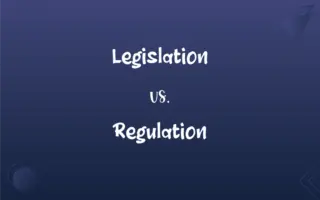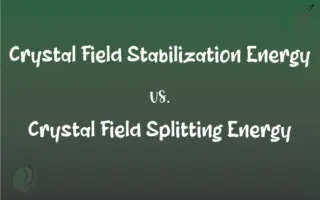Insulated vs. Isolated: What's the Difference?
By Janet White || Updated on March 4, 2024
Insulated refers to being protected from heat, electricity, or sound, using specific materials, while isolated means being set apart, detached, or separated from others or surroundings.

Key Differences
Insulated and isolated are terms that, while sometimes used interchangeably in casual conversation, have distinct meanings based on the context in which they are applied. Insulation involves the use of materials or systems to prevent the transfer of heat, electricity, or sound from one area to another, effectively creating a barrier that maintains different conditions on either side. On the other hand, isolation refers to the state of being separated from others or from a particular environment. This can occur in various contexts, such as geographic isolation, where a location is remote and difficult to access, or social isolation, where an individual or group has limited contact with others.
In technical and scientific contexts, the differences between these terms are more pronounced. Insulation is often discussed in terms of thermal resistance, electrical insulation, and soundproofing, each with specific materials and techniques designed to block or reduce the transfer of energy or sound. Isolation, however, can involve physical barriers, distances, or even psychological states that contribute to a lack of connection or communication.
The choice between insulated and isolated hinges on the desired outcome. Insulation aims to create a controlled environment, whether for comfort, safety, or efficiency, by using materials that have specific properties to resist the flow of heat, electricity, or sound. Isolation, in contrast, aims to achieve separation or detachment, either to protect something or someone from external factors or to prevent the spread of something, such as disease or information, from one area or group to another.
Despite their differences, both terms imply a form of protection or prevention, whether it's safeguarding against environmental conditions, electrical hazards, noise pollution, or the spread of diseases. The context in which they are used be it construction, electrical engineering, medical quarantine, or social situations—determines which term is appropriate and how it is applied.
Comparison Chart
Definition
Protected from heat, electricity, or sound
Separated or detached from others or surroundings
ADVERTISEMENT
Purpose
To prevent the transfer of energy or sound
To achieve separation or detachment
Contexts
Building construction, electrical wiring, soundproofing
Geography, social situations, disease control
Materials/Methods
Insulating materials like foam, fiberglass, rubber
Physical barriers, distance, quarantine measures
Outcome
Controlled environment, safety, efficiency
Protection, prevention of spread, solitude
Insulated and Isolated Definitions
Insulated
Soundproofed.
The studio was insulated to prevent noise leakage.
ADVERTISEMENT
Isolated
Socially detached.
After moving, she felt isolated from her friends.
Insulated
Energy efficient.
Insulated windows can significantly reduce heating costs.
Isolated
Separated for study.
The scientist isolated the compound for further research.
Insulated
Safety-enhanced.
Insulated tools protect workers from electric shocks.
Isolated
Quarantined.
The patients were isolated to prevent the disease from spreading.
Insulated
Protected from heat.
The insulated walls help keep the house warm in winter.
Isolated
Geographically remote.
The island is isolated, miles away from the mainland.
Insulated
To prevent the passage of heat, electricity, or sound into or out of, especially by surrounding or covering with a nonconducting material
Insulate an attic.
Isolated
Far from others or difficult to get to; remote
An isolated farmhouse.
Insulated
To cause to be in a detached or isolated position.
Isolated
Occasional or rare
Reporters in the field observed isolated instances of rebellion.
Insulated
Protected from heat, cold, noise etc, by being surrounded with an insulating material.
Isolated
Characterized by little social contact
Leading an isolated life.
Insulated
Placed or set apart.
An insulated house or column
Isolated
Placed or standing apart or alone; in isolation.
Insulated
(of an electrically conducting material) Isolated or separated from other conducting materials, or sources of electricity.
Early insulated wires were covered in silk rather than plastic.
Isolated
Happening or occurring only once.
Insulated
Situated at so great a distance as to be beyond the effect of gravitation; said of stars supposed to be so far apart that the effect of their mutual attraction is undetectable.
Isolated
Such that no pawn of the same color is in an adjacent file.
Insulated
Simple past tense and past participle of insulate
Isolated
Affecting 10 percent to 20 percent of a forecast zone.
Insulated
Standing by itself; not being contiguous to other bodies; separated; unconnected; isolated; as, an insulated house or column.
The special and insulated situation of the Jews.
Isolated
(medicine) Which has been extracted from the organism.
Insulated
Separated from other bodies by means of nonconductors of heat or electricity.
Isolated
Simple past tense and past participle of isolate
Insulated
Situated at so great a distance as to be beyond the effect of gravitation; - said of stars supposed to be so far apart that the affect of their mutual attraction is insensible.
Isolated
Placed or standing alone; detached; separated from others.
Insulated
Shielded from electricity.
Insulated gloves are essential for electrical work.
Isolated
Not close together in time;
Isolated instances of rebellion
Scattered fire
A stray bullet grazed his thigh
Isolated
Being or feeling set or kept apart from others;
She felt detached from the group
Could not remain the isolated figure he had been
Thought of herself as alone and separated from the others
Had a set-apart feeling
Isolated
Marked by separation of or from usually contiguous elements;
Little isolated worlds, as abruptly disjunct and unexpected as a palm-shaded well in the Sahara
Isolated
Cut off or left behind;
An isolated pawn
Several stranded fish in a tide pool
Travelers marooned by the blizzard
Isolated
Under forced isolation especially for health reasons;
A quarantined animal
Isolated patients
Isolated
Remote and separate physically or socially;
Existed over the centuries as a world apart
Preserved because they inhabited a place apart
Tiny isolated villages remote from centers of civilization
An obscure village
Isolated
Detached from context.
The data, when isolated, provided misleading conclusions.
FAQs
What does it mean to be insulated?
Being insulated means having protection against heat, electricity, or sound through specific materials or methods.
What is the purpose of isolation?
The purpose of isolation is to separate or detach an entity from others or from its surroundings for various reasons, including protection or study.
Can a room be both insulated and isolated?
Yes, a room can be both insulated to prevent energy transfer and isolated to minimize external disturbances or for quarantine purposes.
What are common materials used for insulation?
Common materials include fiberglass, foam, and rubber, each serving to block heat, electrical currents, or sound.
How does geographical isolation affect species evolution?
Geographical isolation can lead to speciation, as separated populations evolve independently, potentially leading to the development of new species.
How do insulated clothing items work?
Insulated clothing traps body heat while preventing cold air from penetrating, using materials like down or synthetic fibers.
Why is insulation important in buildings?
Insulation in buildings is crucial for maintaining comfortable temperatures, reducing energy consumption, and minimizing environmental impact.
What role does insulation play in environmental conservation?
By reducing the need for heating and cooling, insulation helps lower energy use and greenhouse gas emissions, contributing to environmental conservation.
What are isolation measures in healthcare?
Isolation measures include quarantines and the use of protective barriers to prevent the spread of infectious diseases.
Is social isolation always negative?
While often viewed negatively due to its impact on mental health, social isolation can also provide a period of reflection or recuperation.
Can emotional isolation have physical effects?
Yes, emotional isolation can lead to physical symptoms, including increased stress, heart problems, and a weakened immune system.
What are the challenges of living in an isolated location?
Challenges include limited access to services, social interaction, and sometimes, a greater risk of mental health issues due to loneliness.
What is the difference between thermal and acoustic insulation?
Thermal insulation prevents heat transfer, enhancing energy efficiency, while acoustic insulation blocks or absorbs sound, improving sound quality and reducing noise pollution.
What measures can be taken to reduce social isolation?
Measures include community-building activities, increased communication technologies use, and services designed to enhance social engagement and support.
What's the difference between sound insulation and sound isolation?
Sound insulation refers to blocking sound from entering or leaving a space, while sound isolation involves creating a space that is detached from sound sources.
Can isolation be beneficial for mental health?
In some contexts, such as meditation or taking a break from social media, isolation can provide mental health benefits by reducing stress and increasing self-awareness.
How can isolation impact community dynamics?
Isolation can lead to a lack of social cohesion, reduced support networks, and sometimes, an increased sense of community among the isolated group.
How do insulating materials work?
Insulating materials work by trapping air or other gases, minimizing heat transfer due to their poor conductivity and the air's natural resistance to heat flow.
How do quarantine measures during a pandemic differ from standard isolation?
Quarantine measures during a pandemic are often more extensive and may involve large segments of the population to prevent disease spread, unlike standard isolation, which typically targets individuals or small groups.
How does electrical insulation enhance safety?
Electrical insulation prevents the unintended flow of electricity, protecting against shocks, short circuits, and fires.
About Author
Written by
Janet WhiteJanet White has been an esteemed writer and blogger for Difference Wiki. Holding a Master's degree in Science and Medical Journalism from the prestigious Boston University, she has consistently demonstrated her expertise and passion for her field. When she's not immersed in her work, Janet relishes her time exercising, delving into a good book, and cherishing moments with friends and family.








































































